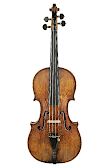Carlo Bergonzi
1683–1747Alongside Amati, Stradivari and Guarneri del Gesù, Carlo Bergonzi ranks among the master luthiers who were to establish Cremona’s international reputation as a center of quality violinmaking. Bergonzi was born to a wealthy miller in 1683. Very little is known about his early youth, but he was probably apprenticed to Vincenzo Rugeri, who died in 1719. He most likely worked exclusively for Rugeri until then, as the earliest instruments with a Bergonzi label were made in the 1720s. Bergonzi got married in 1711 and founded a family. His wife and youngest child died early, in 1730. He never remarried and had to provide for a household with five children as a widower. Nevertheless – or perhaps for exactly this reason – this is when Bergonzi’s most productive creative period began. Numerous archival sources confirm his close relationship with Antonio Stradivari and the latter’s sons. The instruments Bergonzi built during this period plainly exhibit Stradivari’s influence. The arches became flatter, and the broad and thick edges of the belly and back are reminiscent of Stradivari’s later work. After Stradivari’s death in 1737 – which marked the end of an era – the cooperation between Stradivari’s sons and Bergonzi intensified: Carlo’s son Michelangelo had also been apprenticed as a luthier, and in 1745, the Bergonzi family moved to the Casa Stradivari. Stradivari had left a stock of numerous finished and unfinished instruments that his own sons and Bergonzi had to complete and sell. Consequently, building instruments of his own played a subordinate role for Bergonzi in the last years of his life. Carlo Bergonzi died at the Casa Stradivari in 1747.
Bergonzi is now considered the last representative of the Golden Age of violinmaking in Cremona in the 18th century. While his instruments were built entirely in keeping with tradition, they nevertheless exhibit a very personal and unmistakable style. Bergonzi’s instruments display the highest level of craftsmanship. In particular, the distinctive scrolls and the attractive varnish bear testimony to his flawless workmanship. The tone of his instruments also meets the highest standards.


